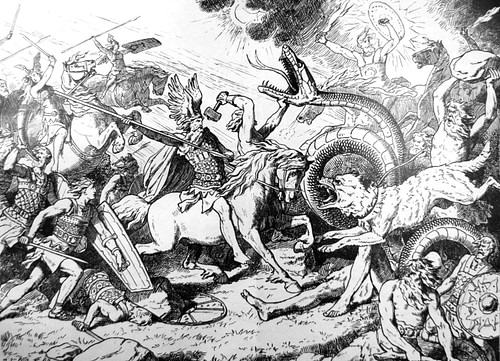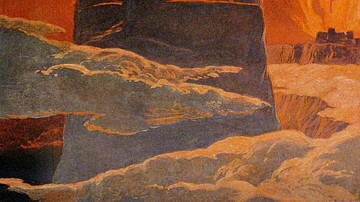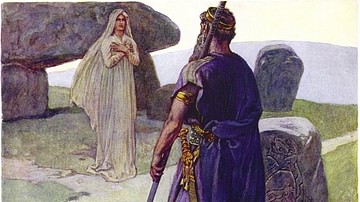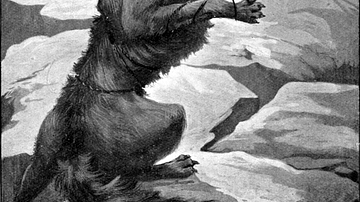
Jörmungandr is the Midgard Serpent (also World Serpent) in Norse mythology who encircles the realm of Midgard. He is the son of the god Loki and the giantess Angrboða and brother of the great wolf Fenrir and Hel, Queen of the Dead. At Ragnarök, the Twilight of the Gods, he slays and is slain by the god Thor.
Fenrir, Jörmungandr, and Hel were living with their mother in Jotunheim, realm of the giants, when the gods of Asgard received a prophecy that they would cause trouble in the future and so Odin ordered them removed when they were still quite young. He hurled Jörmungandr into the sea, consigned Hel to the dark realm of the dead below icy Niflheim, and eventually had Fenrir bound to a rock on an island. Jörmungandr grew to such an enormous size that he encircled the world – which was envisioned as a flat disc - and held his tail in his mouth.
At the end of days known as Ragnarök, Fenrir would break free, Hel would supply him with an army of the dead, and Jörmungandr would release his tail and rise from the seas to join the forces of chaos in battle against the gods and their heroes. The gods would almost all be killed but would defeat their adversaries and preserve order which continued in the rebirth of a new world rising from the ashes of the old.
Jörmungandr is therefore understood by modern-day scholars as an agent of transformation along the lines of the symbolism of serpents in many if not all of the belief systems of the ancient world. Cultures as diverse as those of Egypt, Mesopotamia, and many others frequently feature a serpent as either an adversary of established order or an integral aspect of it but, either way, as transformative entities.
Sources & Origin
His name is pronounced your – mun-gander (also given as Jormungand and meaning "huge monster" or "great beast"), and he is one of the oldest entities in Norse mythology. Jörmungandr features in tales from Skaldic Poetry prior to the 9th century CE when the skald (poet) Bragi Boddason wrote his Ragnarsdrápa ("Ragnar’s Poem"), the oldest skaldic poem extant, which references him. The serpent is also featured in the c. 980-985 poem Húsdrápa ("House Lay") in the section on Thor’s fishing trip with the giant Hymir during which he tries to catch and kill Jörmungandr. An image of this tale is carved on an 11th-century rune stone presently in the National Museum of Denmark.
Jörmungandr appears on several pre-Christian and early Christian rune stones and engravings. The early Norse tales were communicated orally and passed down from generation to generation until the rise of Christianity in Scandinavia and Iceland when literate monks began preserving them in writing. Prior to the Christianization of the region, the only written communication was in runes which, in the words of scholar John Lindow, "are utilitarian, and despite popular conceptions, they have little to say about mythology or magic" (11). Runes were used on memorial stones and "rune sticks" to relay brief messages or give the central meaning of a tale (as with the fishing trip) but were not used for long texts. Lindow comments:
Scandinavian mythology was, with virtually no exception, written down by Christians…all writing, whether in the international language of the church or in the vernacular, was the result of the conversion to Christianity, which brought with it the technology of manuscript writing. (10)
It is unclear why Christian monks preserved the pagan tales except in cases where they are only citing them to attack and dismiss the earlier belief system, but by the 13th century the tradition of preserving older myths was established, and its greatest contributor was the Icelandic historian and mythographer Snorri Sturluson (l. 1179-1241), who preserved the oral traditions in written form.
Sturluson’s Prose Edda drew on works like the Ragnarsdrápa and Húsdrápa to create a complete narrative from the different stories (and different versions) of the world of the Norse gods and the ancient heroes they inspired. Among the many antagonists who threatened the established order, Jörmungandr is often featured and almost always in conflict with the god of thunder and Odin’s son, Thor.
The Stronghold of Utgarda-Loki
Jörmungandr had good reason to find fault with Odin. When he was only a fairly small serpent, Odin had flung him into the sea hoping he would drown. Jörmungandr’s brother Fenrir, however, would be Odin’s sworn enemy and – for reasons never really made clear – Thor would be Jörmungandr’s. The story of Odin kidnapping Loki’s children and binding them in one way or another comes from chapter 34 of the Gylfaginning of the 13th-century Prose Edda by Sturluson. Once Odin has thrown Jörmungandr into the sea, the serpent begins to grow (just as Fenrir does on land) until he reaches such enormous lengths he encircles Midgard, the realm of the mortals. It is at this point that he begins to encounter Thor – first at the castle of a giant and then on a fishing trip.
In the story of Utgarda-Loki ("Loki of the Outlands") from the Prose Edda, Thor is traveling with his human servant Thjalfi and the trickster god Loki when he meets a giant named Skrymir who offers to carry their food bag for them but ties it so tightly that even the mighty Thor cannot open it. Thor attacks Skrymir three times with his great hammer, pounding on his head while the giant sleeps, but each time Skrymir wakes up and asks if maybe a leaf or acorn fell on his head and then leaves the travelers to go on their way.
They arrive at the stronghold of the giant Utgarda-Loki and ask for hospitality, but he mocks them for being so puny and tells them, if they want to spend the night, they must show their worth in competitions. Loki volunteers to go first in a contest of who can eat the fastest and is pitted against Logi of the giant’s court. Loki eats all the meat set before him in the trough, but Logi devours the meat, bones, and even the trough and so is the winner. Thjalfi goes next, entering a race against another courtier, Hugi, and loses all three times.
When Thor’s turn comes, he selects a drinking contest which he is sure to win, but although he drinks three times, he cannot empty the horn and admits defeat. Utgarda-Loki mocks him and says perhaps he will have more luck lifting the gray cat from the floor. Thor can only lift the cat high enough so one paw, waves in the air, and again admits defeat. Utgarda-Loki mocks him again and proposes a wrestling match with the old woman Elli. The two wrestle until Thor is forced down onto his knee and the match is called for Elli. Utgarda-Loki then allows them to spend the night for their efforts.
The next morning, after riding out from the castle with Thor and his companions, Utgarda-Loki explains their experiences. He first reveals that he was the giant Skrymir and he cast a spell to deceive Thor; each time Thor struck him in the woods, he was actually striking mountains which are now all leveled. Once in his castle, the spell continued as Logi was actually not a courtier but wildfire which burned up everything in the trough and the trough itself, and Thjalfi’s opponent Hugi had been thought which runs faster than anything else.
The horn that Thor drank from had its base in the sea so, no matter how much he drank, he could never empty it; he had lowered the sea level so much, however, that he created tides. The gray cat was Jörmungandr, and Utgarda-Loki expresses great admiration that Thor had been able to lift him even that high. The old woman Elli had been old age which no one has any hope of besting. When Utgarda-Loki finishes his explanation, Thor raises his hammer to strike him for the deception, but the giant and his castle vanish into air.
The Fishing Trip
It is never clearly stated why Thor and Jörmungandr hate each other so vehemently but modern scholarship suggests it is because of the insult Thor gave the serpent by trying to raise it from the sea at Utgarda-Loki’s castle and Thor’s unresolved anger at being deceived by the giant, which he then focuses on Jörmungandr. His next encounter with the great serpent is on a fishing trip which seems to begin innocently enough until Thor turns it into an expedition to catch and kill Jörmungandr.
In this story, also from the Prose Edda but first appearing in the Húsdrápa, Thor goes fishing on a large boat with the giant Hymir. When Hymir refuses to offer Thor any bait, the thunder god lops the head off Hymir’s largest ox and affixes it to his hook. They row out to a spot in the sea where Hymir usually has the best luck and catch two whales and several fish. Hymir is content with the trip and wants to return to shore, but Thor takes control of the boat, demanding they go out further to catch the great serpent. Hymir protests, but Thor gets his way, strengthens his line, and baits his new and larger hook with the head of the ox.
Hymir and Thor wait in the boat, and just as Thor had hoped, Jörmungandr takes the bait. Thor hauls the serpent from the sea and reaches for his hammer to kill it while Jörmungandr spews poison from his mouth as he writhes on Thor’s hook. Thor draws the serpent closer in the churning waters, and the boat seems close to capsizing when Hymir, fearing for his life, leans forward and cuts Thor’s line. Jörmungandr dives beneath the surface and escapes while Thor turns on Hymir and, according to different versions, either strikes the giant dead with his hammer or throws him overboard before leaving the boat and wading into shore.
Jörmungandr & Apophis
In an earlier version of the fishing trip tale, Thor is successful and kills Jörmungandr, but this does not fit with the serpent’s later appearance at the end of the world where he is one of the central antagonists of the gods. In the tale of Ragnarök, Jörmungandr joins with Fenrir, Hel, Loki, and the fire giants, among others, as the chaotic force that destroys the world order established by the gods, ushering in a new world.
In this role, Jörmungandr plays the same role as mythological serpents in other ancient cultures. Snakes and serpents almost universally symbolize transformation, rejuvenation, any change in a state of being or consciousness, because of their ability to shed their skin and appear as new. In ancient Mesopotamia, the serpent was associated with the god Ninazu, son of the healing goddess Gula, who carried a staff entwined with serpents and helped his brother Damu in transitioning souls from life to the afterlife. In the biblical tale of the Fall of Man, the serpent offers the temptation which leads to the expulsion of Adam and Eve from the Garden of Eden.
There are many examples of the serpent-as-transformative-agent in cultures around the world, but probably the closest to Jörmungandr is Apophis from ancient Egypt. Apophis (also given as Apep) was the Great Serpent who tried to kill the sun god Ra every night in an effort to plunge the world back into primordial chaos and undo the work of order established by the gods. The Barge of Ra sailed across the sky all day from dawn to dusk before diving below the horizon into the underworld.
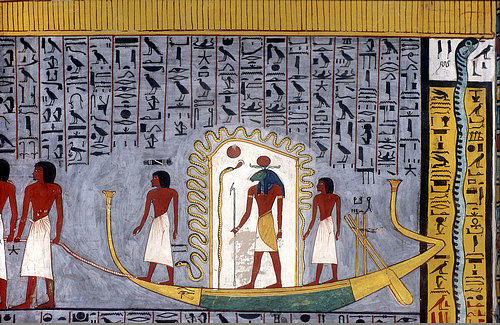
All night long, Apophis would try to attack the ship which was defended by the gods and the souls of the justified dead. Rites were held by the living to support and encourage those on the boat, and their efforts were rewarded the next morning when they saw the sun rise and knew that Ra was safe, and life would continue as it always had. Apophis is regarded as a transformative entity because his attacks required the attention and effort of the living who thereby participated in each new sunrise, transforming darkness into day.
Ragnarök
Both Apophis and Jörmungandr want to destroy the existing order; the difference is that Apophis failed while Jörmungandr did not. The Norns – Fates - had decreed Ragnarök from the beginning of time and there was no appealing their decisions. The gods understood they would die in the great final battle – as did their adversaries – but the battle had to be fought just the same.
At the appointed time, Ragnarök would be signaled by a breakdown in human relationships and traditions accompanied (or followed) by severe winters without summers. Fenrir breaks his chains and rampages throughout the Nine Realms of Norse cosmology destroying everything while his son Sköll swallows the sun and his other son, Hati, devours the moon, leaving the realms without light. The ship Naglfar, constructed of the fingernails of the dead, is driven across the seas by the giant Hrym as Fenrir howls at the gates of Hel and she provides Loki with an army of the dead and a ship, piloted by Loki, carrying this army as well as Surtr and his other fire giants to the battlefield at Vigrid.
Ragnarök is the last time Thor encounters Jörmungandr as the two finally meet in battle. Thor kills the serpent but has been sprayed so thoroughly by Jörmungandr’s poison that he is only able to walk nine paces before falling down dead. Fenrir kills Odin and is in turn killed by Odin’s son Vidarr while Loki is killed by and kills the god Heimdall. Surtr ignites the World Fire, and the Nine Realms fall in flames, but the forces of order are finally triumphant and a new world emerges from the ashes of the old.
Conclusion
Although he is depicted as a 'villain' in the tales, Jörmungandr – like Fenrir and Hel – is an agent of transformation. All three fit the definition of the 'bound monster' as described by John Lindow: a creature who is confined by those hoping to maintain the status quo who breaks loose and destroys the old order so that something new can take its place. Scholar H. R. Ellis Davidson comments:
Thus, the end of the world may be seen as the time when the chained monsters break loose to destroy the gods, or when the forces of nature are unloosed against men and the inhabited earth ceases to exist. (190)
Humans, like the gods of Asgard, tend to resist change and try to control the world to minimize their fear of the unknown, all the while knowing – just like the Norse gods – that change is inevitable, and nothing is permanent. In this regard, Jörmungandr represents the futility of trying to control forces that are ultimately beyond one’s ability to contain, both natural forces and those set in motion through human agency. His defeat at the hands of Thor is, at the same time, his victory in that he kills his old adversary and destroys the world Thor knew, allowing for a new generation of gods in a new world to one day leave behind their own stories to tell.


